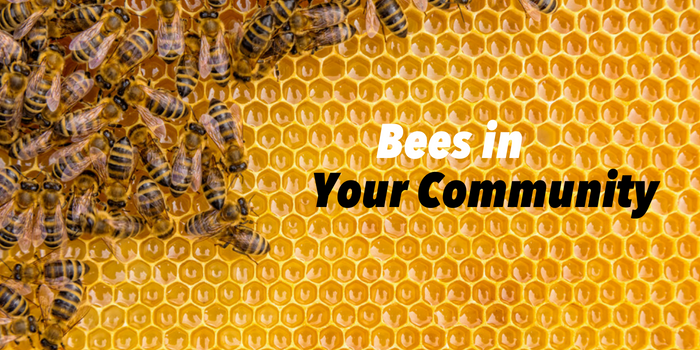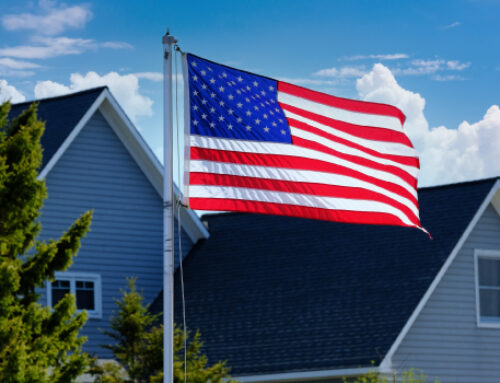It’s troublesome to host an association picnic only to have bees swarm your watermelon and colas, or to start some yard work to find a hive in one your backyard trees. No one likes being stung, and allergic reactions can sometimes follow said stings. But, don’t call for an exterminator! If you’ve spotted a hive or swarm of bees, relocate it instead. Bees are important pollinators with worryingly low populations due to toxic pesticides, shrinking environments, and virus-carrying mites. They’re well worth protecting.
Why do we need bees?
It’s estimated that a third of our food – one in every three bites – is pollinated by bees. This includes tomatoes (and therefore ketchup!), watermelon, apples, coffee (Starbuck!), almonds, and probably any other fruit, vegetable, and nut you can think of.
And, our pollinators aren’t only honey bees. North America has around 4,000 different species of native bees, and these are the ones responsible for a lot of our pollination. People have tried to artificially pollinate plants, but plants that aren’t naturally pollinated don’t reap crops as high in number or quality.
Produce aside, many of us can appreciate honey and all the products made from beeswax, like soaps, candles, and lip balm.
So, why are bees in trouble?
The drop in bee colonies has been connected to pesticide use (especially neonicotinoids), fewer flowering plants, and varroa mites.
- Neonicotinoids, a pesticide that a plant absorbs, kills any pest that tries eating that plant – including the bees that take the nectar and pollen. There are also other pesticides that disorient and sicken pollinating bees.
- Because farms have become monocultures, meaning each farm will only produce one or two crops, bees have to travel long distances to find the food they like. And, even if they like the flowers of the farm’s crop, once those flowers die, the bees will starve because there won’t be any other later-blooming plants nearby.
- Varroa mites infect bees, weakening them by drinking their blood and infecting them with viruses. Think of your cat or dog being infected by very large fleas.
Taken together, these issues have led to Colony Collapse Disorder (CCD), where worker honey bees will actually desert their colonies, leading to the queen’s and the colony’s death, and our shrunken bee population. Through the efforts of beekeepers and the USDA, bee populations have become more stable in recent years, but we have a long way to go before we reach healthy numbers again.
What can an HOA do to help?
This is a daunting, even overwhelming, problem. But, contributing to bee health is easier than you might think! If your association would like to help the bee populations flourish, try some of the following suggestions:
- If you find a hive or swarm in your community, call a local beekeeper, not an exterminator. Encourage homeowners to do the same if they find beehives in their yards or on their homes. Hives in public places, like a park or city-owned street, can be relocated by contacting local officials; try calling your city’s non-emergency service number.
- Plant a large variety of flowering plants in your common areas, and suggest that homeowners do the same in their yards. You could even award bonus points to flower-filled yards in your Yard of the Month competition. The goal is to maintain blooms of bee-friendly, pesticide-free plants consistently from spring to fall. A wide variety of plants will make sure that all our bees are cared for!
- Buy local honey. Not only will you support local beekeepers who maintain colonies in your area, but local honeys are also more natural, so they’re better for you!
We also suggest sharing resources like these with your homeowners:
The Honey Bee Conservancy: This site provides a detailed explanation of the bee crisis, including helpful sources and studies.
Save the bees! Wait, was that a bee?: In this humorous TEDxUSU Talk video, Joseph Wilson explains the diversity of native bees and how we can help them.
Understanding the Emerging Global Honey Bee Health Crisis: This two-page PDF published by the Honey Bee Health Coalition visually depicts the global honeybee crisis.
Bee City USA: This site provides helpful information for choosing plants and creating a bee-friendly garden.
We understand that a board’s first priority is the happiness and welfare of association homeowners. But, by following some of these tips and sharing this information with your members, you can help ensure that the generations to come will continue to enjoy delicious produce and beautiful plants.
For additional questions regarding HOA management, contact Spectrum Association Management today.







